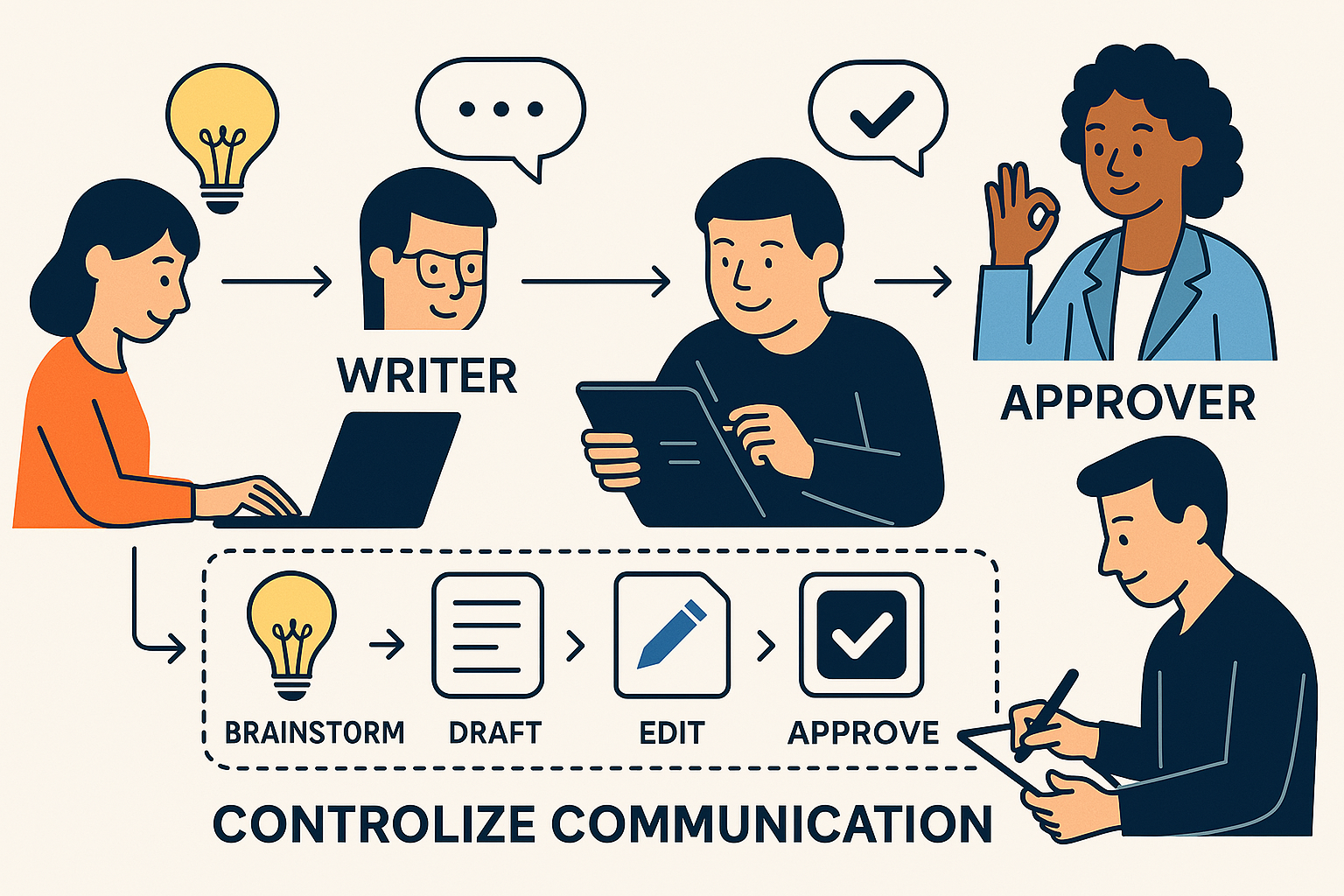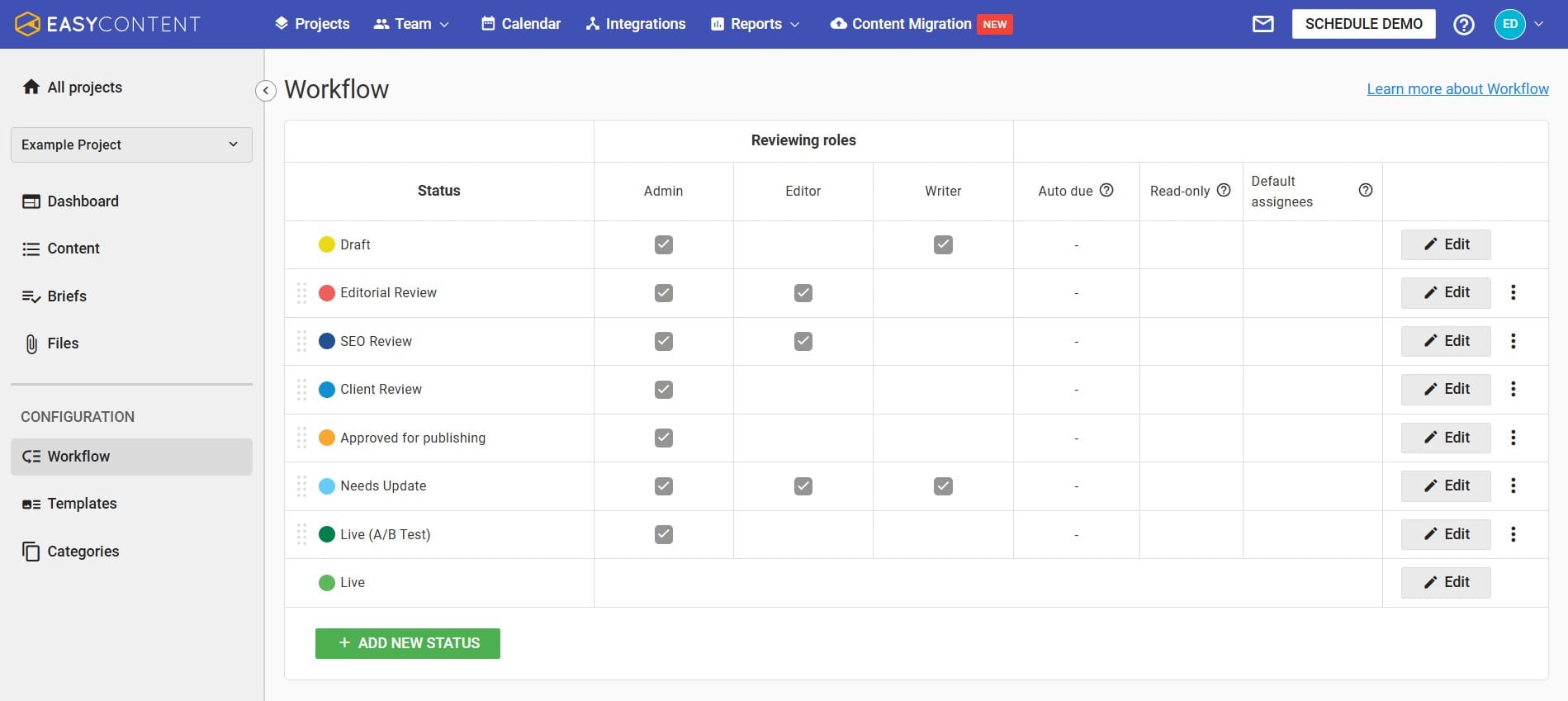How Teams Can Effectively Collaborate on Content Creation: Tools and Strategies That Make a Difference
Effective collaboration in content creation depends on clear processes, good communication, and the right tools. This blog reveals how teams can reduce chaos, speed up production, and improve content quality through structure, automation, and platforms like EasyContent.

Content teams are under more pressure than ever in the fast-paced digital era to produce excellent work while preserving efficiency. Effective content creation is mostly dependent on teamwork, but without the right framework and tools, teams often suffer from misunderstandings, late deadlines, and scattered feedback. Frustration and slow production caused by inefficient processes can seriously impact overall content quality.
Keeping everyone aligned is one of the biggest challenges. Collaborating across multiple platforms—writers, editors, strategists, and designers—can lead to version control issues and miscommunication. Important updates get buried in email threads, and feedback becomes inconsistent, making revisions time-consuming and frustrating. With multiple stakeholders, last-minute changes and approval delays can derail even the most carefully planned content calendar.
Content teams need the right tools and a clear plan to collaborate effectively. That means using a centralized platform where all tasks, ideas, and decisions live. Instead of juggling different tools, teams should adopt one system that improves communication, simplifies decision-making, and keeps everything organized.
This is where EasyContent becomes essential. Unlike traditional document-sharing tools, EasyContent is built specifically to increase efficiency and output for content teams. It provides a single, structured workspace where teams can easily track progress, collaborate in real time, and manage projects. By integrating automated workflows, role-based access, and built-in review systems, EasyContent eliminates clutter and ensures everything runs smoothly and on time.
This blog offers practical tools and strategies to strengthen collaboration among content teams. We'll show how streamlined teamwork helps you move faster, reduce errors, and improve content quality by following clear workflows and using the right technology. Whether remote or in-office, successful digital marketing starts with strong collaboration.
Key Takeaways
The Challenges of Team Collaboration in Content Creation
Sometimes producing material together feels like having too many cooks in the kitchen. Everyone has their own way of working; things get lost, and you end up with something far from the original plan. That’s exactly what happens in content teams when there's poor collaboration structure, leading to miscommunication, inconsistent messaging, and workflow chaos that slows everything down.
Common Collaboration Challenges
| Problem | Description |
|---|---|
| Scattered feedback | Feedback coming in from multiple sources leads to confusion and delays |
| Version control issues | Team members unknowingly work on different drafts |
| Inconsistent content voice | Lack of unified tone across materials with different contributors |
| Approval delays | Slow sign-offs due to informal communication channels |
Consequences
- Wasted time resolving edits
- Duplicated efforts
- Missed deadlines
- Public mistakes
EasyContent steps in by centralizing feedback, keeping everyone on the latest version, and streamlining communication. Teams spend less time tracking changes and more time creating quality content.
Essential Strategies for Improving Content Collaboration
Improving content collaboration isn’t just about working together—it’s about working smart. If your team constantly deals with scattered feedback, unclear responsibilities, and never-ending email chains, it’s time to rethink your workflow.
Key Strategies:
- Define clear roles and responsibilities
- Establish a structured content workflow
- Centralize communication and feedback
- Automate repetitive and administrative tasks

Defining Clear Roles and Responsibilities
When people are confused about accountability, teamwork suffers. One person thinks they’re waiting for feedback, another edits the same draft unknowingly — total chaos.
Clear Roles Breakdown:
| Role | Responsibility |
|---|---|
| Writer | Create engaging, relevant content |
| Editor | Refine structure, clarity, tone, and voice |
| Approver | Final review and sign-off |
| Project Lead | Oversees task assignment and timeline enforcement |
Clear job descriptions lead to faster delivery, less duplication, and more accountability.
Establishing a Structured Workflow
Content creation isn’t just writing—it’s a multi-step process: brainstorming, drafting, editing, approving, and publishing. Without structure, things fall through the cracks, deadlines slip, and frustration builds.
Typical Content Workflow:
- Brainstorm & idea vetting
- Assign tasks and responsibilities
- Draft creation using templates
- Editing and feedback round
- Approval and revisions
- Publishing and distribution
Using templates and style guides ensures consistent branding and structure.
Centralizing Communication and Feedback
Nothing kills momentum like scattered feedback. Some comments in Docs, others in email, another batch in Slack—and suddenly you’ve got five versions of the same draft and no clue which is current.
Benefits of Centralized Communication:
- Threaded comments on documents
- Easy content version tracking
- All feedback in one place
Tools like EasyContent allow teams to:
- Leave in-line feedback
- Tag collaborators for approval
- Resolve comments efficiently
Automating Repetitive Tasks for Efficiency
One of the biggest headaches in collaboration? Chasing approvals or reminding teammates about deadlines. Nobody wants to live in follow-up email limbo.
Repetitive Tasks You Can Automate:
- Task assignments based on user roles
- Notification reminders for deadlines
- Automated approval chains
With EasyContent, these automations are built in — freeing up your team to focus on high-impact work.
Must-Have Tools for Seamless Content Collaboration
| Tool Type | Tool Suggestions | Purpose |
|---|---|---|
| Project Management | Trello, Asana | Visual task tracking and scheduling |
| Content Operations | EasyContent | End-to-end collaboration & publishing workflow |
| Real-Time Editing | Google Docs, Notion | Simultaneous drafting and feedback |
| Communication | Slack, MS Teams | Quick updates and team messaging |
Integrating these tools allows teams to work without switching between multiple apps or losing context.
Project Management Systems: Maintaining Task Order
Ever woke up thinking what’s due today? Working on what is someone else? Project management tools like Trello and Asana let teams manage assignments, set deadlines, and track progress — all without losing sight of priorities.
Imagine juggling blog posts, social media, and email newsletters, all at once. A shared board helps you quickly see who’s doing what and what’s already approved. No need for constant check-ins — just clarity and flow.
Content Management from Above: One Place for Everything
When files are scattered across folders, emails, and desktops, clutter happens fast. EasyContent solves this by centralizing everything — from first drafts to final approvals.
Need to track changes, follow comments, or see what’s approved? All content lives in one place with EasyContent. You get a clear workflow, real-time collaboration, and less waiting around for someone to reply to an email.
Real-Time Editing and Teamwork: No More Divergent Approaches
Ever worked on a doc, only to find a teammate edited a different version? That kind of mess wastes time and kills momentum.
Platforms like Google Docs and Notion allow real-time collaboration. Writers, editors, and managers can edit, comment, and stay in sync — no emailing files back and forth. Everyone’s on the same page, literally.
Tools for Messaging and Communication: Quicker, Clearer Conversations
Email isn’t great for fast replies — we’ve all felt that pain. If you’ve dug through a 20-email thread for one comment, you get it.
Enter tools like Microsoft Teams and Slack. Whether it’s a quick check-in or a brainstorming chat, they keep communication organized and flowing. And when you integrate them with tools like EasyContent, your whole system becomes even smoother.

How EasyContent Simplifies Team Collaboration
A Centralized Workspace
- Drafts, edits, and approvals all live in one place
- Avoid duplicate versions and confusion
Automation Features
- Task assignments based on workflow triggers
- Notifications for overdue items
Commenting & Review System
- Comments are tied directly to content
- Easy version history and rollback
Role-Based Access
- Ensure proper permissions across the workflow
- Prevents accidental overwrites or premature edits
A Centralized System for Content Development
Ever spent 15 minutes searching for the latest draft, only to realize someone edited or deleted the wrong version? It’s frustrating — and common when teams use scattered tools like email or shared drives.
With EasyContent, everything — drafts, comments, approvals, and final versions — is stored in one place. Writers, editors, and managers are all on the same page, reducing confusion and wasted time.
Efficient Process Automation for Quicker Results
Imagine this: a writer finishes a post and emails it to the editor. The editor replies days later. Meanwhile, the writer has moved on, and the content manager wonders why nothing is published. Sound familiar?
With EasyContent, there’s no need to chase updates. The system sends automatic reminders, assigns tasks, and gives managers real-time visibility. The result? Smooth, step-by-step progress — without bottlenecks.
Integrated Review and Commenting System
When feedback is spread across Slack, email, and docs, it’s easy to miss something important. EasyContent keeps all comments linked to the content itself — directly inside the platform.
Need approval? Tag a teammate. Waiting on a client? They get a single-click notification. No more email chains or lost edits. Everything follows a simple and clear review flow.
Role-Based Access and Version Control
Nothing derails progress like someone accidentally overwriting your work. EasyContent uses role-based permissions to ensure that writers write, editors edit, and managers approve — no mix-ups.
Plus, the built-in version history lets you easily restore older drafts if needed, saving time and preventing headaches.
Working Together Without the Chaos
With EasyContent, teams collaborate efficiently and clearly. The platform’s centralized workspace, automated workflows, streamlined feedback, and controlled access eliminate the chaos most teams deal with daily.
If your team spends more time chasing files and approvals than creating great content, it’s probably time for a change. Try EasyContent — and collaborate without the chaos.
Guidelines for Establishing a Culture of Collaborative Content
Having talented writers and editors is vital, but creating a culture of easy collaboration is even more important if you want to produce great content. Sincere communication, meeting deadlines, and using the right tools help teams work efficiently, smoothly, and with less stress.
Unfortunately, teamwork can quickly fall apart into a mess of misunderstandings, conflicting edits, and last-minute chaos if there’s no structure. So how do you build a content culture that ensures clarity and alignment? Here are some proven methods.
Promoting Frequent Check-Ins and Open Communication
Remember playing "telephone" as a kid? That moment when “The cat is on the roof” somehow becomes “The rat stole my soup”? That’s what happens when communication breaks down in content teams.
To avoid that:
- Schedule frequent check-ins to review issues, progress, and upcoming tasks.
- Create a space where everyone feels heard — encourage open feedback.
- Use a single communication platform (like EasyContent) to manage messages, comments, edits, and approvals.
When everything is centralized, collaboration becomes clearer and faster — and nothing gets lost.
Managing Expectations and Setting Realistic Timelines
Unrealistic deadlines are a sure way to burn out your team. A five-page whitepaper by tomorrow? Rushing a blog post without review? That’s a recipe for low-quality work.
Instead:
- Plan ahead and leave enough time for each phase: writing, editing, approval.
- Distribute work evenly to avoid overload.
- Use a platform like EasyContent to assign tasks clearly and set deadlines everyone agrees on.
When expectations are clear and timelines realistic, teams produce better content — without the panic.
Refining Collaboration Through Performance Analytics
You can’t improve what you don’t measure. Instead of relying on gut feeling, use real data to fine-tune how your team collaborates.
Here's how:
- Track how long each stage takes to spot delays.
- Analyze engagement and content performance to see what resonates.
- Pinpoint bottlenecks — if approvals take forever, maybe it’s time to automate.
With EasyContent, teams get real-time insights, spot obstacles quickly, and adjust strategy without the guesswork.
Building a Truly Collaborative Culture
Creating a culture of collaboration doesn’t happen overnight. It takes the right tools, a commitment to open communication, clear expectations, and smart use of data.
EasyContent helps teams minimize friction, streamline feedback, and track results — all in one place.
If content creation feels more like a circus than a smooth operation, it might be time to rethink your process. With the right culture and tools, making content can feel less like work and more like teamwork.
The Final Word: Why Collaboration Wins Every Time
All effective content teams have one thing in common: they collaborate. Content production becomes much simpler, quicker, and less stressful when teams communicate well, follow established procedures, and utilize the correct tools.
Important tactics like assigning specific responsibilities, consolidating feedback, automating routine processes, and using performance data to enhance teamwork have been discussed. Still, the execution of even the most outstanding ideas depends on the right platform.
Why EasyContent Works:
- One-stop hub for all things content
- Workflow automation that reduces manual steps
- Real-time collaboration and feedback
- Role-based access and version control
The time to streamline procedures is now—especially if your business is dealing with content anarchy. Turning your process into one cohesive system helps you focus on what matters most: creating outstanding content.
Try EasyContent. From your team and your sanity — thanks.






